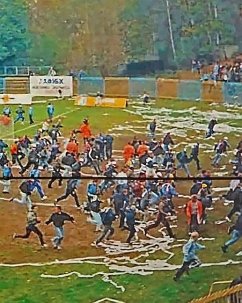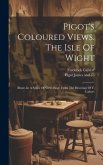- Gebundenes Buch
- Merkliste
- Auf die Merkliste
- Bewerten Bewerten
- Teilen
- Produkt teilen
- Produkterinnerung
- Produkterinnerung
Slash & Burn is a story of a passage; from childhood to adulthood, from communism to capitalism, and from hooligan to artist.
Andere Kunden interessierten sich auch für
![K Foundation Burn a Million Quid K Foundation Burn a Million Quid]() K Foundation Burn a Million Quid22,99 €
K Foundation Burn a Million Quid22,99 €![Pigot's Coloured Views. The Isle Of Wight: Illustr. In A Series Of Views Engr. From The Drawings Of F. Calvert Pigot's Coloured Views. The Isle Of Wight: Illustr. In A Series Of Views Engr. From The Drawings Of F. Calvert]() Pigot's Coloured Views. The Isle Of Wight: Illustr. In A Series Of Views Engr. From The Drawings Of F. Calvert30,99 €
Pigot's Coloured Views. The Isle Of Wight: Illustr. In A Series Of Views Engr. From The Drawings Of F. Calvert30,99 €![Winners In Life Don't Always Win-They Just Don't Give Up Winners In Life Don't Always Win-They Just Don't Give Up]() Chuck SchmandtWinners In Life Don't Always Win-They Just Don't Give Up32,99 €
Chuck SchmandtWinners In Life Don't Always Win-They Just Don't Give Up32,99 €![Into the Inferno: A Photographer's Journey Through California's Megafires and Fallout Into the Inferno: A Photographer's Journey Through California's Megafires and Fallout]() Stuart PalleyInto the Inferno: A Photographer's Journey Through California's Megafires and Fallout23,99 €
Stuart PalleyInto the Inferno: A Photographer's Journey Through California's Megafires and Fallout23,99 €![The Life and Studies of Benjamin West, Esq: President of the Royal Academy of London, Prior to His Arrival in England The Life and Studies of Benjamin West, Esq: President of the Royal Academy of London, Prior to His Arrival in England]() John GaltThe Life and Studies of Benjamin West, Esq: President of the Royal Academy of London, Prior to His Arrival in England34,99 €
John GaltThe Life and Studies of Benjamin West, Esq: President of the Royal Academy of London, Prior to His Arrival in England34,99 €![Living With Edwin Living With Edwin]() Curtis DickmanLiving With Edwin24,99 €
Curtis DickmanLiving With Edwin24,99 €![Happy Anniversary: Chaumet from 1804 to the Present Happy Anniversary: Chaumet from 1804 to the Present]() Molly BlayneyHappy Anniversary: Chaumet from 1804 to the Present11,99 €
Molly BlayneyHappy Anniversary: Chaumet from 1804 to the Present11,99 €-
-
-
Slash & Burn is a story of a passage; from childhood to adulthood, from communism to capitalism, and from hooligan to artist.
Hinweis: Dieser Artikel kann nur an eine deutsche Lieferadresse ausgeliefert werden.
Hinweis: Dieser Artikel kann nur an eine deutsche Lieferadresse ausgeliefert werden.
Produktdetails
- Produktdetails
- Verlag: Hopper & Fuchs
- Seitenzahl: 224
- Erscheinungstermin: 5. März 2025
- Englisch
- Abmessung: 286mm x 232mm x 35mm
- Gewicht: 1024g
- ISBN-13: 9789464002294
- ISBN-10: 9464002298
- Artikelnr.: 71186635
- Herstellerkennzeichnung
- Libri GmbH
- Europaallee 1
- 36244 Bad Hersfeld
- gpsr@libri.de
- Verlag: Hopper & Fuchs
- Seitenzahl: 224
- Erscheinungstermin: 5. März 2025
- Englisch
- Abmessung: 286mm x 232mm x 35mm
- Gewicht: 1024g
- ISBN-13: 9789464002294
- ISBN-10: 9464002298
- Artikelnr.: 71186635
- Herstellerkennzeichnung
- Libri GmbH
- Europaallee 1
- 36244 Bad Hersfeld
- gpsr@libri.de
Marcin Dudek was just ten years old and living in a housing block outside Krakow when the Berlin Wall finally toppled. It was followed by Poland's free fall into capitalism as the country reeled from severe shortages, skyrocketing inflation, and now-defunct industry. A frayed social fabric lacking civic associations left children vulnerable to new allegiances. As a preteen Dudek was swept up by Cracovia, one of Krakow's two viciously sparring soccer fan clubs, whose uniform (shared by other clubs across Eastern Europe) was a black bomber jacket with bright orange lining. Members would collectively turn their jackets inside out in the stadium to signal they were ready to brawl. Like the strike of a match, the blazing orange lining would be revealed, and all hell would break loose. Tied together by unseen bonds, each member of the group was a pawn to the larger mission, acting as one force. One can feel the physical power of the bodies that crowded the stands through their jackets alone, as witnessed in Dudek's monumental installation, Passage. As a testament to the impact of the switch to capitalism in Eastern Europe and the resulting survival economy, hundreds of jackets sent from the West to the East were collected from thrift shops and brought back to the West to be stitched together, creating a monumental coat which envelops, shields, and takes over the viewer. As one ducks to walk through the sleeve and into the path laid out for them, a series of three meticulously-crafted hybrids between collage and painting become visible, all using the jacket and its ability to hold memory, violence, and meaning. Orange lines burnt into the walls on either side of this trilogy are signs of Dudek's performance during the build-up of the exhibition, which baptized the gallery with a smoke grenade like the ones used in his youth. Following this trail, the viewer is brought into a small room with one single padlocked work. When opened, we find a testimony to a life of crime, imprisonment, and self-preservation; the path that Dudek himself would have taken had art not allowed him an escape route. - Excerpt from Amanda Sarroff's essay "The Passage"








